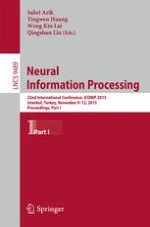2015 | Book
Neural Information Processing
22nd International Conference, ICONIP 2015, Istanbul, Turkey, November 9-12, 2015, Proceedings, Part I
Editors: Sabri Arik, Tingwen Huang, Weng Kin Lai, Qingshan Liu
Publisher: Springer International Publishing
Book Series : Lecture Notes in Computer Science
